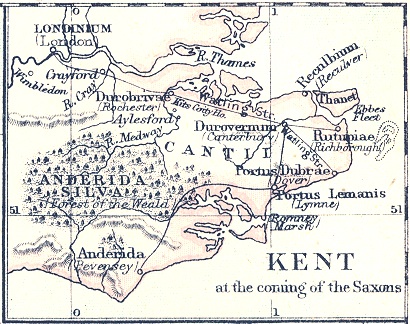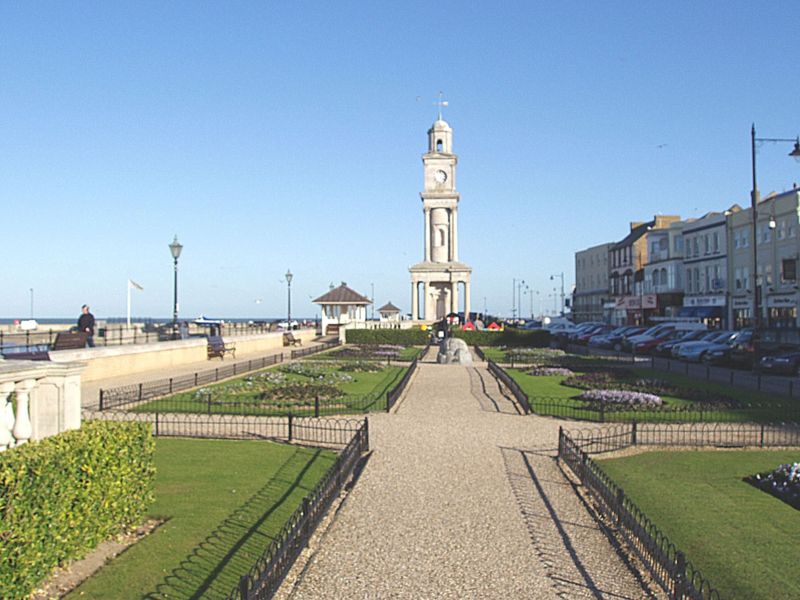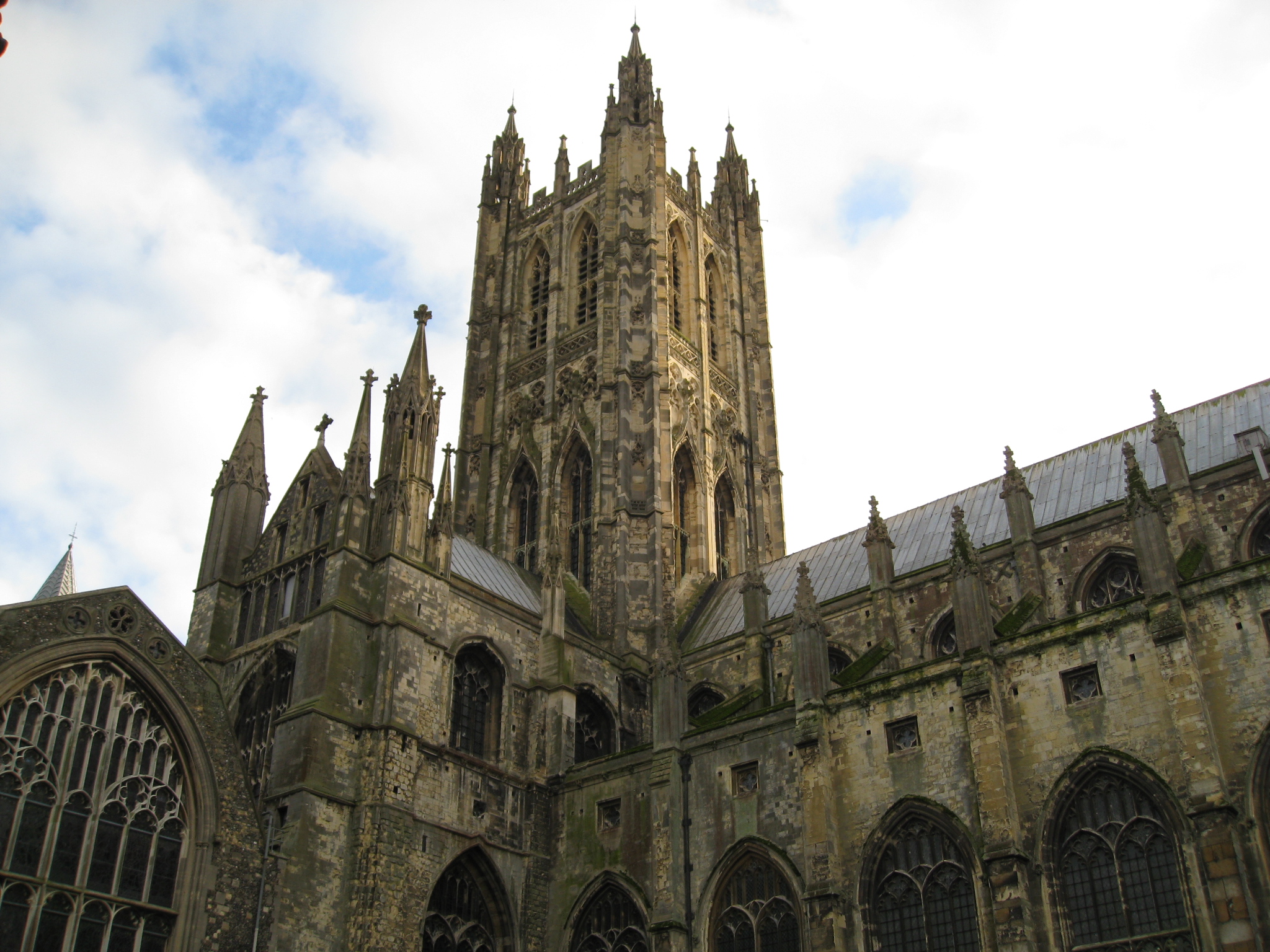|
Sturry
Sturry is a village on the Great Stour river situated northeast of Canterbury in Kent. Its large civil parish incorporates several hamlets and, until April 2019, the former mining village of Hersden. Geography Sturry lies at the old Roman junction of the road from the city to Thanet and Reculver, at the point where a fort was built to protect the crossing of the river. Sturry railway station was opened in 1848 and the line was electrified in 1962, by the South Eastern Railway; it is on the line between Canterbury West and Ramsgate. The station was until the 1860s the stagecoach point for Herne and Herne Bay. The parish boundaries are the same now as they were in 1086 as recorded in the Domesday Book. History Human habitation in Sturry is thought to have started around 430,000 years ago, as dated flint implements - namely knives and arrow-tips - show. Other signs of early human activities include a collection of axes and pottery shards from the Bronze Age and more pottery ... [...More Info...] [...Related Items...] OR: [Wikipedia] [Google] [Baidu] |
Sturry Church
St Nicholas' Church, Sturry, is a joint Anglican and Methodist church standing on a bank beside the River Stour, in the village of Sturry, near Canterbury, in East Kent. The Local Ecumenical Partnership enables the congregation to be of mixed denomination - either Methodist or Anglican. The large parish of St Nicholas incorporates the villages of Sturry with Fordwich and Westbere with Hersden. In 1965 the church was Grade I listed In the United Kingdom, a listed building or listed structure is one that has been placed on one of the four statutory lists maintained by Historic England in England, Historic Environment Scotland in Scotland, in Wales, and the Northern Ire ... by English Heritage. History Early history The first records of a church are from around 690AD. King Wihtred gave Sturry (then called Stour-gau) to the Abbess of Minster-in-Thanet. It is likely that the church then was built on the present site. In 1011AD the Danes invaded and destroyed Minister. Stu ... [...More Info...] [...Related Items...] OR: [Wikipedia] [Google] [Baidu] |
Tithe Barn, Sturry
The Tithe Barn, Sturry, Kent, England is a barn dating from the early 16th century. The barn was built as the tithe barn for the grange of St Augustine's Abbey, Canterbury. At the Dissolution of the monasteries, the grange came into the ownership of Thomas Smythe who converted some of the buildings into a country house, Sturry Court. The barn continued in use for agricultural storage. In the early 20th century, Sturry Court was the country home of Alfred Milner who renamed it Milner Court. On his death in 1925, his widow, Violet, gifted the estate to The King's School, Canterbury which operated a preparatory school on the site. The school was opened by Rudyard Kipling, a friend of the Milners, in 1929. The site is now the Junior School for The King's School and the tithe barn has been restored and repurposed as a performing arts centre. "Sturry's most memorable building", the tithe barn is a Grade I listed structure. History The Abbey of St Augustine was founded in Canterbury ... [...More Info...] [...Related Items...] OR: [Wikipedia] [Google] [Baidu] |
Sturry Railway Station
Sturry railway station is a railway station Kent, England, serving Sturry and Fordwich on the Ashford to Ramsgate line in Kent. It is north east of Canterbury West, and lies either side of a level crossing. The station and all trains serving it are operated by Southeastern. Location and facilities The station is north of Sturry village. It is also the nearest station to the town of Fordwich. The two platforms are staggered and are either side of the A28 road which passes through a central level crossing. The A291 road to Herne Bay is also near the station. Platform 1 provides services towards , and London. Platform 2 provides services towards and . This platform also has a part-time staffed booking office and ticket machines. History The station was opened by the South Eastern Railway on 1 June 1847 It was on the line from to , which had opened on 13 April the previous year. A booking office was added in 1851. In 1887, the station was renamed Sturry for Herne Bay. It r ... [...More Info...] [...Related Items...] OR: [Wikipedia] [Google] [Baidu] |
Canterbury (UK Parliament Constituency)
Canterbury is a Constituencies of the Parliament of the United Kingdom, constituency in Kent represented in the House of Commons of the United Kingdom, House of Commons of the Parliament of the United Kingdom, UK Parliament since 2017 United Kingdom general election, 2017 by Rosie Duffield of the Labour Party (UK), Labour Party. The seat dates to the earliest century of regular parliaments, in 1295; it elected two MPs until 1885, electing one thereafter, before being altered by the later-termed Representation of the People Act, Fourth Reform Act in 1918 (the first being Reform Act 1832, in 1832). Currently, the electorate (the total of people eligible to vote) is much greater than the average nationwide (the electoral quota); this is termed malapportionment, under-apportionment of representation. Constituency profile The seat takes in the cathedral and university city of Canterbury, rural villages to the south, and the seaside resort of Whitstable to the north. Full time stude ... [...More Info...] [...Related Items...] OR: [Wikipedia] [Google] [Baidu] |
Hersden
Hersden is a village east of Canterbury in Kent, South East England. It was established as a planned coalmining village in the 1920s and is on the A28 road between Canterbury and the Isle of Thanet. Work in the Kent Coalfield was the main source of employment in the village until the closure of the Kent colliery in the 1980s. The parish was formed on 1 April 2019 from parts of Sturry, Chislet and Westbere. The Ashford–Ramsgate line, Ashford to Ramsgate railway line runs through the parish to the south of the village. This formerly served the colliery and a station, Chislet Colliery Halt railway station, operated between 1919 and 1971. History A 5th–6th century cemetery of Frisians and Jutes was discovered nearby in 1931. Exploratory works for a Channel Tunnel at Shakespeare Cliff near Dover led to the identification of the Kent Coalfield in 1890. Its northern extension came after coal was discovered at Chislet in 1918. Initially the miners lived in Ramsgate but in 1924 the Ch ... [...More Info...] [...Related Items...] OR: [Wikipedia] [Google] [Baidu] |
Reculver
Reculver is a village and coastal resort about east of Herne Bay on the north coast of Kent in south-east England. It is in the ward of the same name, in the City of Canterbury district of Kent. Reculver once occupied a strategic location at the north-western end of the Wantsum Channel, a sea lane that separated the Isle of Thanet and the Kent mainland until the late Middle Ages. This led the Romans to build a small fort there at the time of their conquest of Britain in 43 AD, and, starting late in the 2nd century, they built a larger fort, or ''castrum'', called '' Regulbium'', which later became one of the chain of Saxon Shore forts. Following the withdrawal of the Western Roman Empire in ca. early C4th, the Brythons again took control of the lands until Anglo-Saxon invasions shortly afterward. By the 7th century Reculver had become a landed estate of the Anglo-Saxon kings of Kent. The site of the Roman fort was given over for the establishment of a monaste ... [...More Info...] [...Related Items...] OR: [Wikipedia] [Google] [Baidu] |
Staddle Stones
Staddle stones (variations include steddle stones) were originally used as supporting bases for granaries, hayricks, game larders, etc. The staddle stones lifted the granaries above the ground thereby protecting the stored grain from vermin and water seepage. In Middle English staddle or stadle is ''stathel'', from Old English ''stathol'', a foundation, support or trunk of a tree. They can be mainly found in Great Britain, Norway ("stabbur"), Galicia and Asturias (Northern Spain). Origins The name itself and evidence from surviving vernacular buildings with wooden 'feet' suggest that at first the staddles or supports were made of wood, such as at Peper Harow granary in Surrey.Quiney, Anthony. (1995). ''The Traditional Buildings of England''. Thames & Hudson. p.174. Stone staddles were longer lasting and a more reliable means of supporting structures which were sometimes a considerable weight. The name has become integrated into the landscape with bridges, houses, farms and o ... [...More Info...] [...Related Items...] OR: [Wikipedia] [Google] [Baidu] |
City Of Canterbury
The City of Canterbury () is a local government district with city status in Kent, England. As well as Canterbury itself, the district extends north to the coastal towns of Whistable and Herne Bay. History The district was formed on 1 April 1974 by the merger of the existing city of Canterbury with the Whitstable and Herne Bay Urban Districts, and Bridge- Blean Rural District. The latter district entirely surrounded the city; the urban districts occupied the coastal area to the north. Politics Elections for to all seats on the city council are held every four years. After being under no overall control for a number of years, the Conservative party gained a majority in 2005 following a by election and defection from the Liberal Democrats. Following the 2019 United Kingdom local elections the political composition of Canterbury council is as follows (2017 results follows by-elections): Meeting place After the Church of the Holy Cross, which was commissioned by Ar ... [...More Info...] [...Related Items...] OR: [Wikipedia] [Google] [Baidu] |
Herne Bay, Kent
Herne Bay is a seaside town on the north coast of Kent in South East England. It is north of Canterbury and east of Whitstable. It neighbours the ancient villages of Herne and Reculver and is part of the City of Canterbury local government district, although it remains a separate town with countryside between it and Canterbury. Herne Bay's seafront is home to the world's first freestanding purpose-built Clock Tower, built in 1837. From the late Victorian period until 1978, the town had the second-longest pier in the United Kingdom.Herne Bay Pier at www.theheritagetrail.co.uk (accessed 7 July 2008) The town began as a small shipping community, receiving goods and passengers from London en route to Canterbury and |
Canterbury
Canterbury (, ) is a cathedral city and UNESCO World Heritage Site, situated in the heart of the City of Canterbury local government district of Kent, England. It lies on the River Stour. The Archbishop of Canterbury is the primate of the Church of England and the worldwide Anglican Communion owing to the importance of St Augustine, who served as the apostle to the pagan Kingdom of Kent around the turn of the 7th century. The city's cathedral became a major focus of pilgrimage following the 1170 martyrdom of Thomas Becket, although it had already been a well-trodden pilgrim destination since the murder of St Alphege by the men of King Canute in 1012. A journey of pilgrims to Becket's shrine served as the frame for Geoffrey Chaucer's 14th-century classic ''The Canterbury Tales''. Canterbury is a popular tourist destination: consistently one of the most-visited cities in the United Kingdom, the city's economy is heavily reliant upon tourism. The city has been o ... [...More Info...] [...Related Items...] OR: [Wikipedia] [Google] [Baidu] |
Oast House
An oast, oast house or hop kiln is a building designed for kilning (drying) hops as part of the brewing process. They can be found in most hop-growing (and former hop-growing) areas and are often good examples of vernacular architecture. Many redundant oasts have been converted into houses. The names oast and oast house are used interchangeably in Kent and Sussex. In Surrey, Hampshire, Herefordshire and Worcestershire they are called hop kilns. They consist of a rectangular one- or two-storey building (the "stowage") and one or more kilns in which the hops were spread out to be dried by hot air rising from a wood or charcoal fire below. The drying floors were thin and perforated to permit the heat to pass through and escape through a cowl in the roof which turned with the wind. The freshly picked hops from the fields were raked in to dry and then raked out to cool before being bagged up and sent to the brewery. The Kentish dialect word ''kell'' was sometimes used for kilns ("The ... [...More Info...] [...Related Items...] OR: [Wikipedia] [Google] [Baidu] |
Museum Of Kent Life
Kent Life (formerly the Museum of Kent Life) is an English open-air museum located at Sandling, next to Allington Locks, on the east bank of the River Medway. History Sir Garrard Tyrwhitt-Drake bequeathed the Cobtree Manor Estate to Maidstone Borough Council in 1966. A part of the estate was Sandling Farm, on the banks of the Medway. In 1984 a decision was made to restore the derelict farm as part of a rural life museum. The museum opened to the public on July 6, 1985.Kentish Oasts p159 Farming At the museum, various aspects of farming are recreated. There are two small hop gardens, growing Fuggles and Goldings hops. Apple and plum orchards, a herb garden, a soft fruit garden and various livestock. Buildings The museum has a variety of buildings, most of which have been dismantled and re-erected at the museum. Barn A five bay barn dating from the eighteenth century and originally at Vale Farm, Calcott, near Sturry. The barn has an oak frame and a thatched roof. It w ... [...More Info...] [...Related Items...] OR: [Wikipedia] [Google] [Baidu] |






